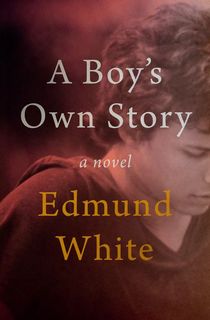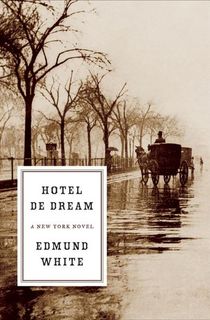He said it all in a 2006 interview with The Sydney Morning Herald: "Writing has always been my recourse when I've tried to make sense of my experience or when it's been very painful. When I was 15 years old, I wrote my first (unpublished) novel about being gay, at a time when there were no other gay novels. So I was really inventing a genre, and it was a way of administering a therapy to myself, I suppose.”
But he hasn’t finished writing it all just yet, even as he nears the age of eighty-four. White just published an appropriately named, and appropriately mature novel, The Humble Lover, this year.
American author Edmund White (born 1940) can now proudly claim credit for sixteen novels, four anthologies, fourteen feats of nonfiction, and one very politically charged play (this was Terre Haute in 2006). Modern day readership enjoys the privilege of calling White the spiritual descendant of the great writers of fiction, such as Marcel Proust and Christopher Isherwood, who not only identified as homosexual but translated aspects and themes of their sexuality into adventuresome works of creative writing.
They did this in time periods where publication of such material was the equivalent to wearing a shirt with a massive red bull’s eye target on it. White, in the late twentieth century, skated on thin ice as he began publishing his own brand of books, even in an age where the world was transitioning, and subversive identities were finally beginning to become public. This didn’t stop him, and the early twenty-first century welcomed a whole new batch of his works.
White himself has claimed to be a studious disciple of the French postwar “Theatre of the Absurd” era author Jean Genet, notorious for the resolutely erotic Our Lady of the Flowers, which follows the life of a drag queen sex worker dying of tuberculosis. Genet’s influence on White is as clear and identifiable as blood relations. Characters cut from the same cloth populate White’s own literary universe.
They can be met in the following highly recommended fiction works, while the equally recommended non-fiction texts are an opportunity to become better acquainted with White himself and the many experimental writers and artists he admires so much.

A Boy's Own Story
The first of a semi-autobiographical trilogy, A Boy’s Own Story can be considered White’s own first chapters of life, albeit with some fictionalizations. Racked with physical and romantic desires for other men, excluded from any sort of relatable community or support network, and surrounded by judgmental conservatives, White’s young self-insert narrator naturally develops a secreted angst around his own sexuality. An infatuation with a childhood friend, casual sexual encounters at too young an age, twisted “therapy” (which convinces him his homosexuality is a psychological disorder) and a fate-sealing, prohibited exchange with a music teacher all infuse into what can only be described as a rather traumatic childhood and adolescence.
This book is a distressing but necessary account of what being a closeted homosexual was like in 1950s America: an incredibly lonely and isolated affair, with countless dangers and little reprieve. The upside is that White, at the time of writing, had come to full terms with his identity and was able to record his memories with a degree of triumphant objectivity. The most attractive aspect of the book is White’s signature mastery of scene description, as demonstrated in this particularly impressive excerpt:
“For the real movements of a life are gradual, then sudden; they resist becoming anecdotes, they pulse like quasars from long-dead stars to reach the vivid planet of the present, they drift like fog over the ship until the spread sails are merely panels of gray in grayer air and surround becomes object, as in those perceptual tests where figure and ground reverse, the kissing couple in profile turn into the outlines of the mortuary urn that holds their own ashes.”
Readers interested in learning what happens next to White’s survivalist narrator can investigate the direct sequels The Beautiful Room Is Empty (1988) and The Farewell Symphony (1997) afterwards. The Beautiful Room Is Empty is notable for including White’s records of participating in the 1969 Stonewall Riots, while The Farewell Symphony effectively uses a Haydn metaphor to capture the heartbreaking, realistic experience of losing relationships as one grows older.

The Flâneur: A Stroll Through the Paradoxes of Paris
It’s almost a legal precedent for any major writer who has lived in or visited the City of Lights at any point in their life. They must write a book about it. Paris is where a writer truly lives, and Paris is what sells on the market. But while writers like Ernest Hemingway with his A Moveable Feast includes readers in the fast-paced, hard-playing, and hard-partying lifestyle he enjoyed as an expatriate in the 1920s, White takes a more relaxed approach with his own Francophile memoir of his slots of time spent in the city.
Unlike Hemingway, White isn’t racing like mad from one sensation to another and plunging into a nonstop fest of experience-gluttony. He is taking Paris in, slowly, as a flâneur. A casual stroller, a languid observer and commentator, taking his time, absorbing everything, and savoring it so he can later translate it into a memoir of aesthetic pleasures, art, personal philosophy, and history. As he establishes in the very first chapter, a pair of functional feet in Paris can take one anywhere they like. The artful flâneur, if curious enough and careful enough with their time, can carry themselves to any destination:
“In Paris,” White writes. “You can visit the sewers and the catacombs. You can meet collectors of Barbie dolls. You can go to a Buddhist centre in the Bois de Vincennes (strangely, the buildings were originally designed for the Colonial Exposition of 1931 as the pavilions for Togo and the Cameroons). You can visit a wax museum, the Musée Grevin, where chic people sometimes give private parties in the miniature theatre filled with likenesses of Rudolf Nureyev and Pavarotti. You can go to a restaurant that serves just caviar or another that serves just cheese.”
That, White asserts throughout the text, is the greatest appeal of Paris. Choices. And his choice is to experience it all as a very well-satisfied pedestrian.

Hotel de Dream
Legendary American author Stephen Crane, best known for The Red Badge of Courage, is dying in poverty, and risks leaving his beloved domestic partner Cora destitute. In a last-ditch attempt to raise some funds before he breathes his last, Crane dictates to Cora what White reimagines as his final and now-lost novel. Thus the novel dives into a frame narrative that makes one think of Scheherazade of One Thousand and One Nights: an expert storyteller telling a story, a beautiful story, out of pure desperation.
Hotel de Dream, named after the bordello previously owned and managed by Cora, is a testament to both Crane and White’s shared belief that no subject is too taboo for great literature. With Crane on his deathbed, and his lover by his side, they conceive the character of a late nineteenth-century boy prostitute in New York who becomes a married man’s object of obsessive affection.
The two pursue a precarious, and doomed, love affair, in defiance of Victorian society’s norms and laws. In the true style of White, this work is an exploration of dangerous, undercover homosexuality that plays with hearts and fire. Hotel de Dream also stands as a triumph of historic fiction, in that it is loyal to the realities of its era while maintaining a fascinating Gothic aura suitable for its setting.

The Unpunished Vice: A Life of Reading
It would be a challenge to find an author who worships books as ardently as White. So much, in fact, that he himself considers the activity of reading a contraband, all-consuming pleasure on par with delicious cocktails, fine dining, and gay sex. The Unpunished Vice is White’s velvety hybrid of literary criticism and memoir, offering readers a private tour through his serious and sensuous relationship with books, from youth to adulthood. At one point, White followed a paramour to New York City. While there, he engaged in a secondary affair with the poems of Ezra Pound, his boyfriend’s favorite writer. True bookworms will understand completely.
Present also is White’s frequent commentary on what constitutes good, appetizing writing and what, with considerable disdain for form and style, churns out bad, unpalatable writing. Being a veteran book reviewer, White can safely be considered an authority on the subject, and readers will be happily introduced to many new, obscure, and competent writers that they’ve probably never heard of before. The only period in his life where White wasn’t reading compulsively was the aftermath of his heart surgery in 2014. When he resumed his passion for books, the lost time only spurned him on to write a tribute to the only vice that has never done him, or anyone else, any harm.


